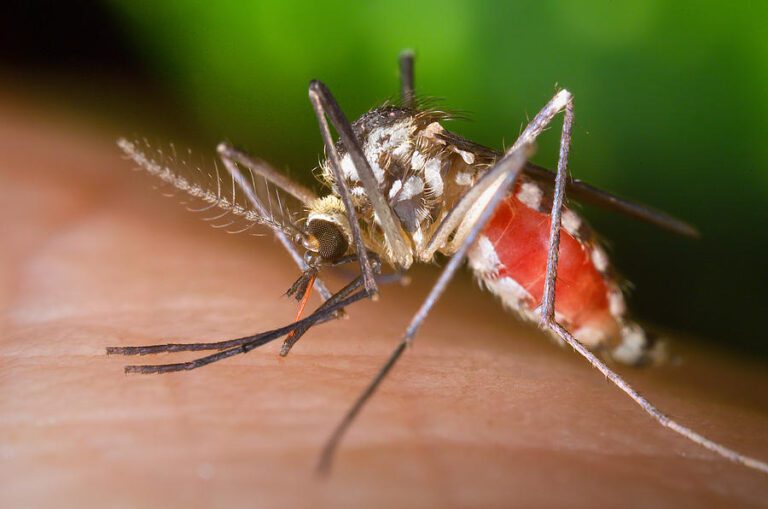What is Eastern Equine Encephalitis Virus and How Does it Spread?
Eastern equine encephalitis virus (EEEV), also known as the Triple E virus or sleeping sickness, is a zoonotic alphavirus and arbovirus, that was first recognized in horses in 1831 in Massachusetts. The first confirmed human cases were identified in New England in 1938. EEEV is present today in North, Central and South America, and the Caribbean. In rare cases, those who contract the virus will develop the serious neuroinvasive disease, Eastern equine encephalitis (EEEV). Understanding the EEE virus and its impact is crucial for helping protect public health.
EEEV is a vector-borne disease that is transmitted to humans through the bite of an infected mosquito. Culiseta melanura is the primary vector among birds, but this mosquito species does not typically feed on humans. It is believed that EEEV is mainly transmitted to humans and horses by bridge vectors that have contracted the virus by feeding on infected birds. Bridge vector species of EEE virus mosquitoes may include Coquillettidia pertubans, Aedes sollicitans, and Ochlerotatus canadensis. These EEE mosquito species play a significant role in transmitting the EEE virus to humans and horses.
The risk of contracting the EEE virus is highest during the summer months, and those who live and work near wetland and swamp areas are at higher risk of infection. EEEV is only spread to humans via mosquito bite, and cannot be transmitted directly by other humans or horses. There is an EEEV vaccine available for horses, and owners are encouraged to discuss vaccination with their veterinarian.
Signs and Symptoms of Eastern Equine Encephalitis
Symptoms of EEE Infection
- Symptoms of the EEE virus typically occur four to ten days after a bite from an infected EEE mosquito and include:
- Fever
- Headache
- Vomiting
- Muscle aches
- Joint pain
- Fatigue
- In rare cases, infection occurs in the brain and spinal cord, leading to:
- Sudden high fever
- Stiff neck
- Disorientation
- Seizures
- Coma
- The mortality rate of those that develop EEEV is about 33%, the highest among arboviruses transmitted in the U.S.
Treatment of EEE Infection
- As of now, there are no vaccines or antiviral treatments available specifically for the EEE virus.
- For severe illnesses, supportive treatment includes:
- Hospitalization
- IV fluids
- Respiratory support
Eastern Equine Encephalitis: A Rare but Serious Neuroinvasive Disease
EEE, also referred to as the Triple E, is a rare but very serious disease that involves inflammation and swelling of the brain. Fortunately, only 5% of human EEEV infections result in EEE. However, one out of three people who develop EEE will die, and many survivors have mild to severe brain damage. This highlights the importance of controlling EEE virus mosquitoes through effective management programs.
Of those who contract the EEE virus, the elderly (ages 50 and older) and young (ages 15 and younger) are at the greatest risk of developing encephalitis.
Eastern Equine Encephalitis and the United States

In 2024, a total of 19 human cases of Eastern Equine Encephalitis (EEE) were reported across nine states in the United States. The highest number of cases occurred in the Northeast, particularly in Massachusetts, which had the most reported infections. Other affected states included New York, New Jersey, North Carolina, Georgia, Wisconsin, and a few others in the Midwest and along the East Coast.
EEE continues to be most commonly reported in the eastern and Gulf Coast states, but cases have also been identified in inland Midwestern regions. The presence of Aedes and Culiseta mosquito populations in these areas contributes to the risk of infection.
Public health officials emphasize mosquito surveillance and control as key strategies in mitigating the spread of EEE. Given the severity of the disease, with most cases classified as neuroinvasive, prevention efforts focus on reducing mosquito exposure and increasing awareness in high-risk areas.

A Global View of Eastern Equine Encephalitis
EEE affects areas throughout North and South America, with outbreaks occurring mainly in the eastern coastal areas of the United States and Canada, the Caribbean, and Argentina.
Know Your Eastern Equine Encephalitis (EEE) Mosquitoes
In the U.S., Culiseta melanura is the primary EEE mosquito responsible for the spread of the virus in the mosquito-bird-mosquito cycle. Known as the black-tailed mosquito, Cs. melanura can be found in swamps from the Great Lakes and Maine to southern Florida and southeastern Texas. It is distinguished by its unusually long, curved dark-scaled proboscis. This mosquito is also unique because it overwinters as larvae, as opposed to most mosquito species that overwinter as adults or eggs.
EEEV is mainly transmitted to humans by bridge vectors that contract the virus by feeding on infected birds. Bridge vectors may include Aedes, Coquillettidia, and Culex species.
Aedes mosquitoes have distinct black and white markings on their body and legs. They bite during the daytime only, with the highest levels of activity occuring in the early morning and evening hours. Members of the Aedes genus are known vectors of EEEV, Zika virus, dengue, yellow fever, West Nile virus, and chikungunya.
Coquillettidia mosquitoes have slender bodies and long legs. They are commonly found in humid, low-lying areas that have warm summers and lots of vegetation. In addition to acting as vectors for EEEV, Coquillettidia mosquitoes are also known to transmit West Nile virus to humans.
Culex mosquitoes are brown with whitish markings on the abdomen. They typically bite at dusk and at night, and are known to vector several diseases including EEEV, West Nile virus, Japanese encephalitis, St. Louis encephalitis, and avian malaria.

Controlling Mosquitoes and Eastern Equine Encephalitis
An Integrated Mosquito Management (IMM) program is essential to controlling EEE virus mosquitoes and preventing the transmission of Eastern equine encephalitis. As part of an effective IMM program, VDCI recommends a 4-pronged approach to target all phases of the EEE mosquito’s life cycle.
Mosquito control professionals can only do so much, and this is why we rely on a well-educated public in order to have a successful mosquito control program. Educating the public empowers people to take control of the mosquitoes breeding in their back yard and gives them the tools needed to reduce mosquito annoyance.
2: Surveillance
Surveillance allows us to detect mosquito species in a given area as well as any changes in populations. With this valuable data, we are able to more effectively time larvicide applications and more accurately target adulticide activities.
Our trained field technicians inspect both known sources of standing water and any newly discovered sites for the presence of mosquito larvae. Eliminating mosquitoes prior to their becoming adults is an important element of controlling EEEV and other mosquito-borne diseases because it stops mosquitoes before they acquire the virus and have the opportunity to transmit it to people.
When necessary, adulticide applications are conducted with EPA-approved pesticides that are used in the safest and most environmentally sound way possible. Additionally, VDCI regularly tests adult mosquitoes and takes all appropriate measures to prevent them from developing resistance; thereby, minimizing the number of applications needed to control the population.

VDCI is a company built on the foundations of public health, ethics, professionalism, and technical expertise. We establish vector management programs that are based on an understanding of the underlying vector’s ecology and rooted in the current science of environmentally sound control measures.

